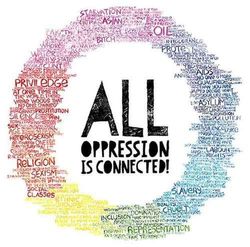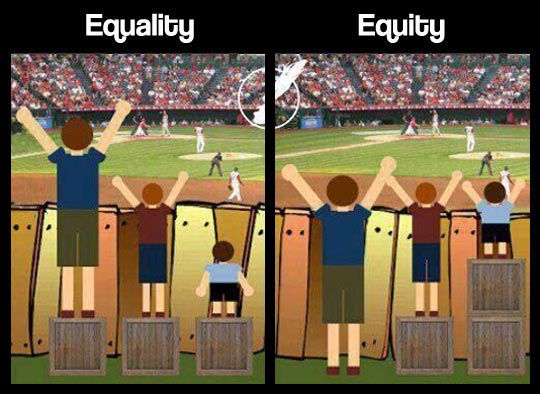r a c i s m d e f i n e d
|
The definition of racism offered here is grounded in Critical Race Theory, a movement started in the 1970s by activists and scholars committed to the study and transformation of traditional relationships of race to racism and power. CRT was initially grounded in the law and has since expanded to other fields. CRT also has an activist dimension because it not only tries to understand our situation but to change it. The basic beliefs of CRT are:

PREJUDICE An attitude based on limited information, often on stereotypes. Prejudice is usually, but not always, negative. Positive and negative prejudices alike, especially when directed toward oppressed people, are damaging because they deny the individuality of the person. In some cases, the prejudices of oppressed people (“you can’t trust the police”) are necessary for survival. No one is free of prejudice. Examples: Women are emotional. Asians are good at math. ADVANTAGE
OPPRESSION The systematic subjugation of one social group by a more powerful social group for the social, economic, and political benefit of the more powerful social group. Rita Hardiman and Bailey Jackson state that oppression exists when the following 4 conditions are found:
Oppression = Power + Prejudice SOCIAL and INSTITUTIONAL POWER
SYSTEM
WHITE SUPREMACY The idea (ideology) that white people and the ideas, thoughts, beliefs, and actions of white people are superior to BIPOC communities and people and their ideas, thoughts, beliefs, and actions. While most people associate white supremacy with extremist groups like the Ku Klux Klan and the neo-Nazis, white supremacy is ever present in our institutional and cultural assumptions that assign value, morality, goodness, and humanity to the white group while casting Black, Indigenous, and People of Color as worthless (worth less), immoral, bad, and inhuman and "undeserving." Drawing from critical race theory, the term "white supremacy" also refers to a political or socio-economic system where white people enjoy structural advantage and rights that other racial and ethnic groups do not, both at a collective and an individual level. For more, go to the white supremacy culture page. RACE
RACISM
Racism is different from racial prejudice, hatred, or discrimination. Racism is when the power elite of one group, the white group, has the power to carry out systematic discrimination through the institutional policies and practices of the society while shaping the cultural beliefs and values that support those racist policies and practices. |
When white Americans frankly peel back the layers of our commingled pasts, we are all marked by it. We … are marred either by our connections to the specific crimes and injuries of our fathers and their fathers. Or we are tainted by the failures of our fathers to fulfill our national credos when their courage was most needed. For more about the social and political construction of race, visit Race: The Power of An Illusion.
|
HOW OPPRESSION OPERATES
CYCLE OF OPPRESSION
Find out what people will submit to, and you have found the exact amount of injustice and wrong which will be imposed upon them ... |
In order for oppression (racism in this case) to flourish, we must: forget / pretend – the oppressed must "forget" (or refuse to see) what has happened to them historically and what is happening to them in their day to day lives in order to get through their day; the dominant group must never identify as benefiting from white privilege; those in the dominant group must "forget" (or refuse to see) how their membership in the white group informs their lives; those in the dominant group must pretend that everything is OK now, that any problem was in the past lie – the oppressed must stop speaking the truth about their experience, both to themselves (to survive internally) and to others (to survive in the world); the dominant group must lie to themselves and each other about their role in oppression, positioning themselves as blameless, passive (I didn’t cause it), individual and not part of a bigger system, while ignoring the internal racist conditioning and tapes (I am not racist, I’m a good white person) stop feeling – the oppressed must cut themselves off from their feelings, become numb in order to survive, or feel that it is personal (I am bad or at fault); the dominant group must also cut themselves off from their feelings, insist on being ‘rational and ‘logical’ and never stop to feel the cost of how their participation in oppression dehumanizes both those they are oppressing and themselves; the dominant group must avoid feeling, because to feel will inevitable lead to unbearable guilt or shame lose voice – the oppressed must internalize the oppression, feel bad about themselves and their situation so that they are no longer able to speak to it or about it, distrust their voice and the truth they have to speak; when the oppressed do speak out, they are labeled as ‘aggressive,’ ‘overly sensitive,’ ‘angry,’ and discounted; the dominant group becomes afraid to speak out because of the social pressure against speaking the truth, the threat of losing family and friends, and the cost of separating themselves from the white group make power invisible – the oppressed must begin to identify more with the dominant group than with their own group and as a result lose a sense of their collective power; the dominant group must assume their right to power along with the myth that power is individual and everyone who works hard can have the same power they do; or the dominant group must act as if they don’t have power as white people and deny the power that they get just by belonging to the white group |
three expressions of racism
|
CULTURAL . The ways in which the dominant culture is founded upon and then defines and shapes norms, values, beliefs and standards to advantage white people and oppress BIPOC communities and people. The ways in which the dominant culture defines reality to advantage white people and oppress BIPOC communities and people. The norms, values, or standards assumed by the dominant society that perpetuate racism. Examples: thin, blond, white women as the basis for our society's standard of beauty; women on welfare assumed to be Black or Brown and portrayed as irresponsible while white collar fraud in the business community is costing the US hundreds of billions of dollars a year; requiring people to speak English historically (Indigenous peoples) and today (people from Central and South America) as a way of deliberately destroying community and culture. INSTITUTIONAL . The ways in which the structures, systems, policies, and procedures of institutions in the U.S. are founded upon and then promote, reproduce, and perpetuate advantages for white people and the oppression of BIPOC communities and people. The ways in which institutions legislate and structure reality to advantage white people and oppress BIPOC communities and people. The ways in which institutions -- Housing, Government, Education, Media, Business, Health Care, Criminal Justice, Employment, Labor, Politics, Church – perpetuate racism. Examples: BIPOC communities and people under-represented and misrepresented on television, racially biased standardized tests used to determine who will be admitted to higher education programs and institutions, historic and ongoing breaking of treaties with indigenous Native American communities, reliance on low-paying undocumented immigrant labor by farms and factories. PERSONAL . The ways in which we perpetuate and/or assume the idea that white people are inherently better and/or BIPOC communities and people are inherently inferior on an individual basis. The ways in which white people act out of racist implicit bias. Examples: calling someone a racist name, making a racist assumption.
|

The Milken Institute School of Public Health at George Washington University offers their insight into this graphic.
Paul Kuttner offers some insight into the much used graphic that attempts to illustrate the difference between equality and equity. Take a look here.
|
|
This animation commissioned by the African American Policy Forum offers a metaphor for the obstacles of structural racism.
|
Read here about Bob Herbert's documentary Against All Odds: The Fight for a Black Middle Class which presents a clear case study of structural racism in the U.S.
Read here about 7 Ways We Know Systemic Racism is Real. 10 Ways to Practice Institutional Racism at Your Non-Profit Organization. By Korbett Mosesly. |





